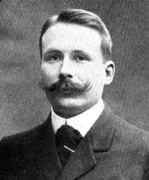Person: Chazy, Jean François

Jean Chazy was a French mathematician and astronomer who worked on the three body problem.
Mathematical Profile (Excerpt):
- Jean began his studies at the Collège of Mâcon and then went on to perform outstandingly at the Lycée in Dijon.
- At this time the École Normale Supérieure had the best reputation for mathematics and, as this was Chazy's chosen topic, he began his studies at the École normale.
- Conscription was one way of achieving this, and after graduating, Chazy undertook military service for a year before continuing with his studies.
- Although Painlevé had made many advances, he had also posed many questions and it was these that Chazy attacked.
- Chazy published several short papers while undertaking research, for instance Sur les équations différentielles dont l'intégrale générale est uniforme et admet des singularités essentielles mobiles Ⓣ(On differential equations whose general integral is uniform and admits mobile essential singularities) (1909), Sur les équations différentielles dont l'intégrale générale possède une coupure essentielle mobile Ⓣ(On differential equations whose general integral has a mobile crucial break) (1910) and Sur une équations différentielle du premier ordre et du premier degré Ⓣ(On differential equations of the first order and first degree) (1911).
- In 1911, Chazy was appointed as a lecturer in mechanics at the University of Grenoble.
- By good fortune the Academy of Sciences posed a topic for the Grand Prix in Mathematical Sciences of 1912 which was exactly right given the research that Chazy had undertaken for his thesis.
- The judges, one of whom was Paul Painlevé, received a number of outstanding submissions for the prize, including one from Chazy.
- In the end they decided to split the award three ways giving a one-third share to each of Chazy, Pierre Boutroux and René Garnier.
- Chazy moved from Grenoble to Lille where he was appointed as a lecturer in the Faculty of Sciences (later renamed the University of Lille).
- Chazy was mobilised and sent to the sound reconnaissance laboratory which was set up at the École Normale Supérieure.
- Chazy was able to compute the position of the Big Bertha guns firing at Paris from long-range with surprising accuracy.
- For his war work Chazy was awarded the Croix de Guerre.
- Once he was released from military service in 1919, Chazy returned to his position in Lille.
- Having done brilliant work on differential equations, Chazy's interests now turned towards the theory of relativity.
- In the same year, Chazy published a paper on the three-body problem, Sur les solutions isosceles du Problème des Trois Corps Ⓣ(On the isosceles solutions of the three body problem), an area he had begun to study in 1919 and for which he has become famous.
- Several important papers on the three-body problem followed, such as Sur l'allure du mouvement dans le problème des trois corps quand le temps croît indéfiniment Ⓣ(On the speed of the movement in the three-body problem when the time increases indefinitely) (1922) which led to Chazy being awarded the Prix Benjamin Valz.
- In 1923 Chazy was appointed as a lecturer at the École Centrale des Arts et Manufactures in Paris and he was also appointed as an examiner at the École Polytechnique.
- in the 1920s, the French mathematician Jean Chazy made an important advance.
- Chazy, however, had no clue as to whether it could exist.
- Chazy published a number of influential texts while working as a professor in Paris.
- In 1933, Chazy published another two-volume work, namely Cours de Mecanique Rationelle Ⓣ(Rational mechanics course).
- In 1953 Chazy published Mécanique céleste.
- Thus, beyond the lasting insights that Chazy brought to various aspects of the new theories, his example remains particularly interesting for the philosophy of science.
- Chazy received many honours for his contributions.
Born 15 August 1882, Villefranche-sur-Saône, France. Died 9 March 1955, Paris, France.
View full biography at MacTutor
Tags relevant for this person:
Astronomy
Thank you to the contributors under CC BY-SA 4.0! 

- Github:
-

- non-Github:
- @J-J-O'Connor
- @E-F-Robertson
References
Adapted from other CC BY-SA 4.0 Sources:
- O’Connor, John J; Robertson, Edmund F: MacTutor History of Mathematics Archive
